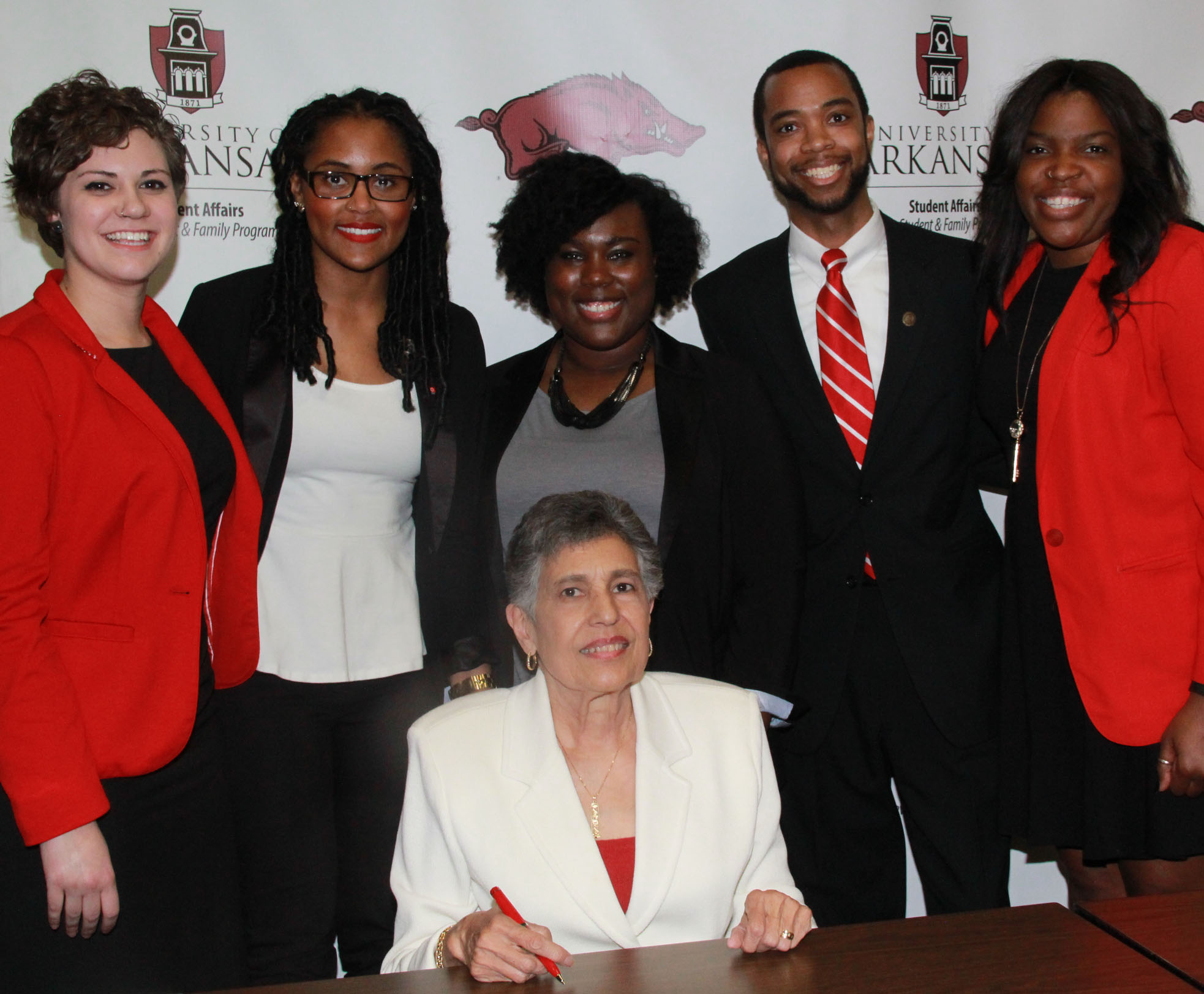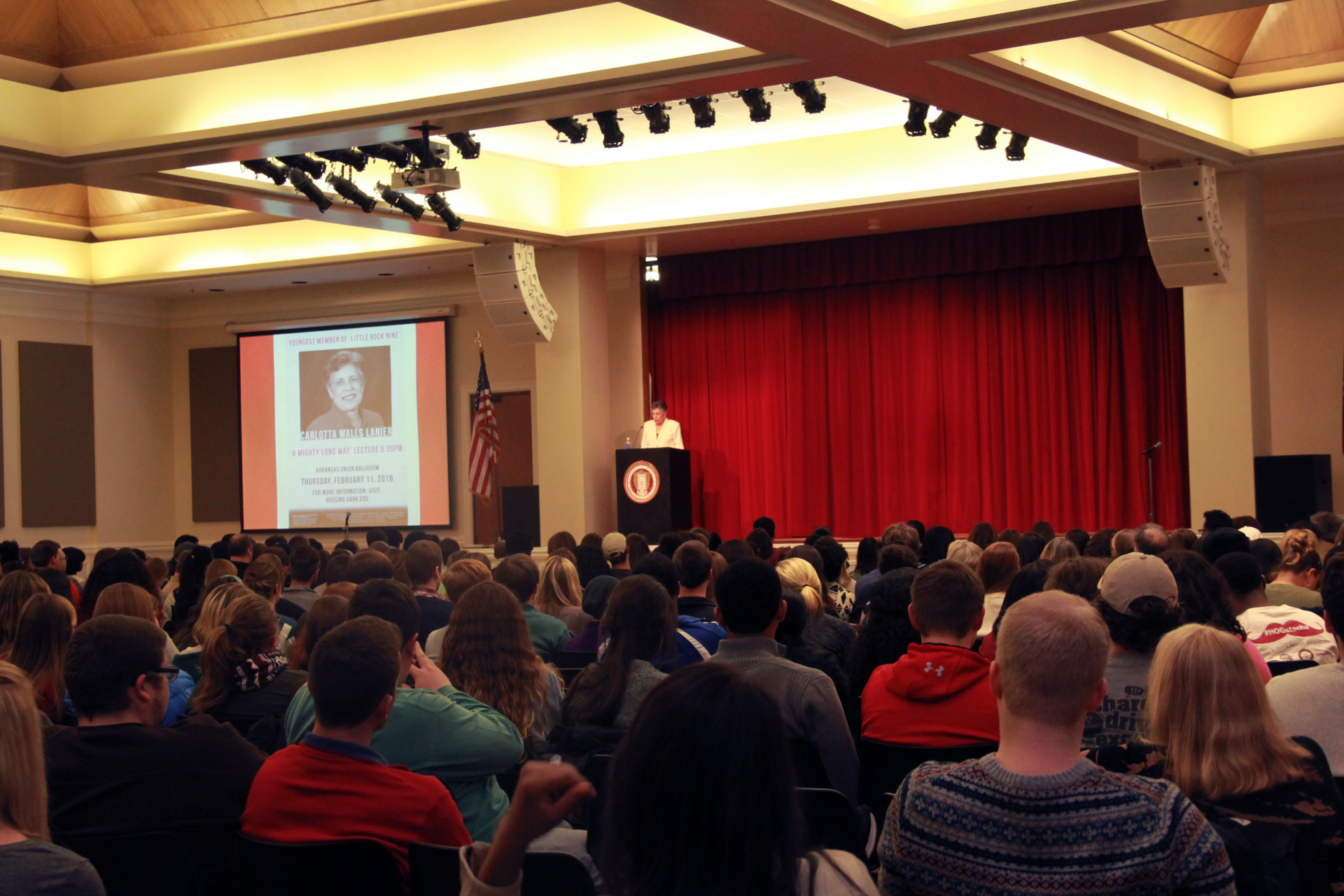
Civil rights icon and National Women’s Hall of Fame inductee Carlotta Walls LaNier spoke to the University of Arkansas community on Feb. 11. LaNier spoke about her experience at Central High School as a member of the Little Rock Nine and the history of desegregating education in the South.
In 1957, fourteen-year-old Carlotta Walls was the youngest member of the Little Rock Nine, the group of African American students who integrated Central High School. She and eight other students faced angry mobs and racist elected officials in a crisis that required federal intervention by President Dwight D. Eisenhower. She had no way of knowing that day was the beginning of a journey that would challenge prevailing attitudes, break down barriers, and forever change the social landscape of America.
LaNier is known for motivating audiences with her personal story of perseverance and strength and bringing to life a moment in history that changed the world while inspiring hope for the future.
Madeleine Chaisson, resident assistant and president of the Volunteer Action Center, said having LaNier come and speak was an opportunity to hold an open dialogue about race on the U of A campus.
Chaisson and three other students have been working to bring LaNier to campus since last year. The students wanted to remind the university community about where it has come and help them to continue to move forward. After getting funding and support from different departments and offices across the Division of Student Affairs and the community, Chaisson said they were able to solidify plans to bring LaNier to campus.
“We wanted the night to be about an open dialogue. Mrs. LaNier not only presented the history piece and helped us understand how times have changed, but she discussed where we’re at now. She presented her view, looking through her lens at what she’s seen and gave us her take on how we’ve progressed and how we can move forward to be a unified society accepting diversity across the board.”

Over the next year, Chaisson, Franklin, Kiper, and Moore would work tirelessly to bring LaNier to campus and facilitate a larger discussion of race in a space where students could feel free to ask questions and confront hot topics not normally tackled in the public sphere.
To Hall, Chaisson, Franklin, Kiper, and Moore it was important to not only appreciate where the state and the nation had been concerning civil rights and racial relations, but to also discuss the current climate and how to continue improving the future.
“We wanted the night to be about an open dialogue,” Hall said. “Mrs. LaNier not only presented the history piece and helped us understand how times have changed, but she discussed where we’re at now. She presented her view, looking through her lens at what she’s seen and gave us her take on how we’ve progressed and how we can move forward to be a unified society accepting diversity across the board.”
Hall said the experience helped the students to grow in their beliefs, but also in their professional development.
“Not only was this an amazing event to hold for the campus community, but also a great learning experience for the students,” Hall. “They had to work on finding funding, organizing a large scale event, while keeping their central goal in mind – bring awareness and an open discussion on racial relations from the past and present to the university community.”
Kwamesha Moore, resident assistant and social work, African and African American studies student, said she and the other students were concerned about the communities exposure to the Little Rock Nine and LaNier’s story.
“Although Mrs. LaNier and the Little Rock Nine’s story is rooted in Arkansas and our national history, many students might not be familiar with such a historic event. We wanted to educate those who may not have known about the Little Rock Nine as well as give students who are familiar with her story a chance to hear her personal accounts,” Moore said. “We also wanted students to realize that although it may seem like such a long time ago, the Little Rock Nine and their movement are still relevant today as it relates to racial equality, diversity, and inclusion.”
“It was great to see such a big turnout. It makes me very hopeful that the students at this great institution just might be the next generation of change. To have so many RSOs, teachers, and staff promote and encourage students to come means that this university is willing to support efforts made to ensure equality and inclusion.”
“Mrs. LaNier is a person who is working towards a bigger goal than just reliving her past. She is not dwelling in her experience, but sharing it so the rest of us can move forward,” Franklin said. “I feel like students who aren’t necessarily from Arkansas or even if you are, may not know everything about the Little Rock Nine. I feel like it was important for somebody to come in and give us a view of how we got where we are and to remind us that its important not to revert to where we’ve been. It was an excellent educational event, not necessarily just for minorities that go to the U of A, but for everyone as a whole.”
Prior to the event, a faculty-led panel took place, allowing students to ask questions about and discuss topics regarding the racial climate of the past and present.
“All the panelists brought a different perspective with their backgrounds in social work, African and African American studies, criminal justice, and history,” Moore said. “They provided great tips on how to effectively discuss topics of race and other social constructs and identities with peers.”
Something that surprised all of the student leaders were the questions the audience asked and their willingness to openly discuss racial relations.
“It was great to see such a big turnout. It makes me very hopeful that the students at this great institution just might be the next generation of change,” Moore said. “To have so many RSOs, teachers, and staff promote and encourage students to come means that this university is willing to support efforts made to ensure equality and inclusion.”



“I would say our biggest goal for the event was to make people more aware of the past and also how its kind of repeating itself for the present and make it okay for people to talk more openly about those topics. It’s about spring-boarding those talks that need to be had that are often avoided because they are often hot topics.”
“It was awesome seeing all the students engaged and eager to ask questions at the end of the lecture,” Kiper said. “Some asked questions where the answer was needed to be heard by others in the audience. Others asked questions that gave them personal resolve. And others asked questions that gave passage to a personal but educated reply.”
“I was surprised at how challenging their questions were,” Franklin said. “They were asking questions that had to do with their personal involvement in making the University of Arkansas a better place. I feel like that takes a large amount of accountability to put on yourself to want to assume those roles and be willing to play a part in that to ensure we’re moving forward and not regressing backward.”
Franklin said their main goal for the event was to just start a conversation.
“I would say our biggest goal for the event was to make people more aware of the past and also how it’s kind of repeating itself for the present and make it okay for people to talk more openly about those topics. It’s about spring-boarding those talks that need to be had that are often avoided because they are often hot topics,” Franklin said. “I would say that’s been accomplished even in the willingness of the audience to participate in the questions and answer portions and confront those difficult ideals and in the amount of people who stayed after to get one of Mrs. LaNier’s books signed by her. You could tell they were now invested in her in what she had been through and were willing to get to know her better and hear her story as a way to develop a passion to move forward.”
Chaisson said this goal was at the center of everything the group did in preparation for the event.
“My main hope was that the event left everyone a little more educated on the civil rights movement and what happened at Central High School. I think it’s really important to recognize what has happened in the past so we can move forward. While we have made great strides, we still have work to do.”
After spending time with Mrs. LaNier, the students themselves were struck by her selflessness and personal bravery.
“She was so excited to be here and have the opportunity to speak at the University,” Kiper said. “It was hard not to feed off her energy. When her lecture started, her words and her ability to tell her story and educate us on a piece of American history at the same time lit a passion in me. It was like I was sitting around my Grandma’s kitchen table in New Orleans being inspired and impassioned by her stories of what life was like during Jim Crow Laws.”
“When Mrs. LaNier read an excerpt from her book talking about a bomb that was thrown into her house, that really stuck with me,” Franklin said. “I can honestly say that I would have been out of there. That story just proves what a selfless person she is. Her selflessness is something I hope to embody as I grow and move through life.”
Sponsors for the event included Charles and Cappy Whiteside Code to Creed Program New Student & Family Programs, the Office of the Dean of Students, University Housing, Residents’ Interhall Congress, the Center for Multicultural and Diversity Education, the Honors College, Greek Life, the School of Law, PROFOUND Pioneer Entertainment Group, National Residence Hall Honorary, and the School of Social Work.
